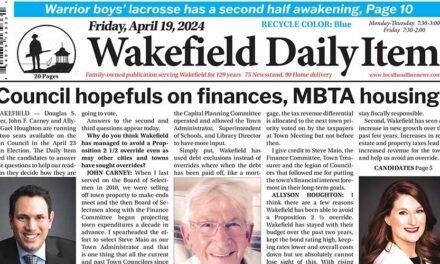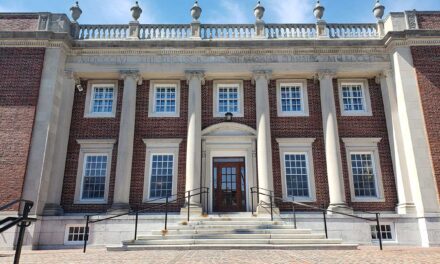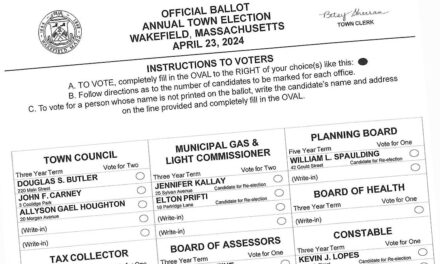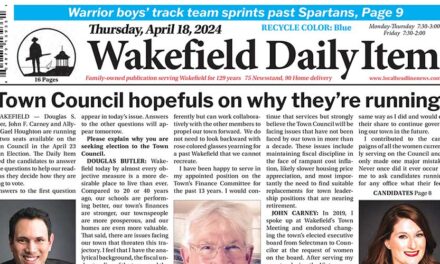Published in the June 26, 2018 edition.
By MARK SARDELLA
WAKEFIELD — Water and sewer rates will be going up starting July 1, after the Town Council approved the new rates last night. But even after the increase, local residents will still be paying less than those living in Reading and Melrose.
That’s what DPW Director Richard Stinson told the Town Council last night as he presented the Advisory Board of Public Works-recommended Water and Sewer rates for Fiscal Year 2019. Stinson appeared before the board with new Assistant Director of Public Works Joe Conway. Stinson said that Conway will be replacing DPW Business/Operations Manager Carol Antonelli, who is retiring.
The new water rate will be $7.20 per cubic foot of consumption, up from last year’s $6.95. The new rate provides for an average annual water bill (after the discount is taken) of $777.60, or $194.40 per quarter. The average annual bill is calculated on the basis of 12,000 cubic feet (89,760 gallons) of consumption.
The new sewer rate of $11.35 per 100 cubic feet of consumption is up from $10.95 in FY 2018. The new rate provides for an average annual bill of $1,225.80 or $306.45 per quarter.
Stinson noted that the average combined water and sewer bill will be $2,003.40 or $500.85 per quarter. This represents a combined average increase of $75.60 year or $18.90 per quarter.
Stinson stressed that a gallon of town water costs the consumer about 2.5 cents, compared to about $1.30 for a store-bought, 16-ounce bottle of water. Due to all the testing that is done to assure the purity of town water, Stinson said, it is “probably of better quality and safer” than bottled water.
Both the water and the sewer rates need to fund the operating budgets of the Water and Sewer Divisions, Stinson said. Both are self-sufficient, enterprise departments.
The water and sewer rates also need to be sufficient to cover consumption shortfalls, emergencies and future capital improvements, he added. Consumption in FY 2018 was down and impacted water and sewer revenues and reserves.
Stinson said that ideally reserves on the water side should be in the range of about $2 million, but as of June 30 will be at about $450,000. On the sewer side, reserves should at about $1 million, which they are currently. Stinson estimated that in the unlikely event that all goes perfectly, on June 30, 2019 those sewer reserves will be down to about $863,000.
The Massachusetts Water Resources Authority assessment (the amount the town pays to the MWRA) continues to be the most significant factor in the water and sewer budgets, Stinson said.
The MWRA water assessment accounts for 43 percent of the Water Division budget, Stinson noted, and 77 percent of the Sewer Division budget.
In response to a question from Councilor Julie Smith-Galvin, Stinson discussed the fact that reduced consumption through conservation impacts revenues and can result in higher rates because the cost of running each department remains the same despite lower consumption. It was noted that the proliferation of bottled water is just one factor in lower consumption, along with more efficient appliances, toilets and shower heads.
“Our consumption is now lower than it was in 1959,” Stinson said. Back in the 1990s, Stinson added, Wakefield’s annual water consumption was around a billion gallons. “Now it fluctuates between 620 million and 680 million gallons.”
Stinson indicated that the laws of supply and demand apply.
“It’s no different than any other product or commodity,” he said. “The more you use, the less it costs per unit. The less you use, the more it costs per unit.”
In addition to approving the new water and sewer rates, the Town Council set the sewer flat rate at $340.50 per quarter ($306.45 aft the discount). The sewer flat rate is paid by those using well water rather than town water.
The Council also approved a meter fee (manual read) to be applied in cases where households have not responded to three or more requests by the town to replace the meter.




